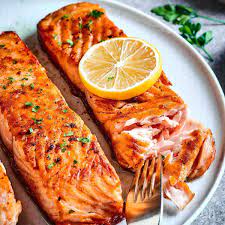Introduction:
Salmon, with its vibrant pink hue and rich flavor, holds a special place in both the culinary and ecological realms. This remarkable fish is not only a favorite on the dinner plate but also plays a crucial role in the ecosystems it what does salmon taste like. From its life cycle to its nutritional benefits, let’s dive into the fascinating world of salmon.
Life Cycle:
Salmon are known for their anadromous behavior, meaning they hatch in freshwater, migrate to the ocean to grow and mature, and then return to freshwater to spawn. This unique life cycle is a testament to the adaptability of these incredible creatures. There are several species of salmon, including Chinook, Coho, Sockeye, Pink, and Chum, each with its own distinct characteristics and habitats.
Spawning Season:
The spawning season is a pivotal time in the life of a salmon. Adult salmon return to the same rivers or streams where they were born, overcoming obstacles like waterfalls and strong currents. Once they reach their spawning grounds, female salmon create nests, or “redds,” by using their tails to dig depressions in the gravel. The females then deposit their eggs, which are fertilized by males. After completing this arduous journey, salmon, having fulfilled their reproductive duties, often succumb to exhaustion.
Culinary Delight:
Salmon’s delectable taste and versatility have made it a staple in cuisines around the world. Whether grilled, smoked, baked, or raw in sushi, salmon’s rich, oily flesh imparts a distinctive flavor. Additionally, salmon is a nutritional powerhouse, packed with omega-3 fatty acids, high-quality proteins, and essential vitamins like B12 and D. Its health benefits make it a favorite among health-conscious individuals.
Environmental Importance:
Beyond its culinary appeal, salmon plays a crucial role in maintaining the health of aquatic ecosystems. As they migrate between freshwater and saltwater environments, salmon transport nutrients, influencing the productivity of both ecosystems. Their carcasses, after spawning, provide essential nutrients for streamside vegetation and aquatic organisms.
Conservation Challenges:
Despite their significance, salmon face numerous threats, including habitat destruction, overfishing, and climate change. Dam construction, pollution, and deforestation disrupt their spawning grounds, affecting the entire life cycle. Conservation efforts, including habitat restoration, sustainable fishing practices, and climate change mitigation, are essential to ensuring the continued survival of salmon populations.
Conclusion:
Salmon, with its remarkable life cycle, culinary appeal, and ecological importance, stands out as a symbol of resilience and interconnectedness in our natural world. As consumers, it is crucial to support sustainable practices to ensure the preservation of this magnificent species for future generations to enjoy both on their plates and in the wild. By understanding and appreciating the marvels of salmon, we can contribute to the conservation of not only this incredible fish but also the delicate ecosystems they call home.


